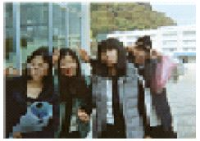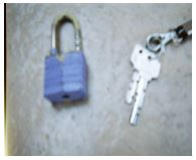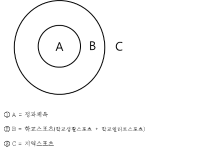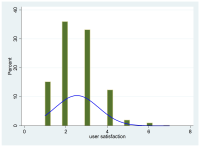
Recently, there have been diverse types of physical activities supported by government policy in S. Korea. However, these activities may not be effective if they do not reach to moderate to vigorous level. This study designed school physical education system based on SPARK program, which include traditional physical education, sports club based physical activity, after school physical activity, and Saturday physical activity, to evaluate its effectiveness associated with physical fitness and empirical meanings of physical activity. This study employed a mixed method research paradigm for better understanding. Among various mixed method paradigm stances, this study employed "blending strategy" for complementary analysis. First of all, the effectiveness in health condition was evaluated by quantitative data. Specifically, physical fitness and lifestyle were analyzed by Helmas, IPAQ, and Accelerometer respectively. Second, empirical meanings of physical activity were analyzed by both Photovoice and in-depth interview which are qualitative research method. The result of this study first showed that a specially designed school physical activity program based on the SPARK contributed to improve students' physical fitness and lifestyle as well, however, there were important differences between male and female students. Second, physical achievement, alteration of spatiotemporal meaning, and change of societal relationship emerged as important themes. Further, these themes showed that they played an important role to maintain students' motivation in physical activity and consequently physical activity promotion was invigorated in school. Based on these results, we synthesized investment factors and process factors and outcome factors respectively. Finally, we suggested alternative teaching methods and suggestions for following research to overcome gender issues.










PURPOSE This study aims to investigate the effects of three perceived benefits of physical activity classes on class satisfaction, college satisfaction, well-being, and workout intention, as well as the moderating effects of sports characteristics on the relationships between the benefits and outcomes. METHODS A total of 282 questionnaires were collected from university students enrolled in physical activity classes during the semester. Confirmatory factor analysis, structural equation modelling (SEM), measurement invariance testing, and multi-group SEM were conducted using the Mplus 7.0. RESULTS Euphoric and social benefits positively affected class satisfaction. Class satisfaction, in turn, influenced college satisfaction, well-being, and workout intention. Sports characteristics moderated this relationship between the benefits of physical activity class and class satisfaction. CONCLUSIONS These findings offer practical insights for promoting student engagement and long-term participation in physical activity.
PURPOSE This study analyzed the relationship among coaching behaviors, motivational climate, sports competence, effort, and failure tolerance as perceived by high school athletes. Additionally, it examined whether motivational climate, competence, and effort mediate the relationship between coaching behaviors and failure tolerance. METHODS Using questionnaires measuring autonomy-supportive coaching behavior, controlling coaching behavior, motivational climate, sports competence, effort, and failure tolerance, 365 high school athletes were surveyed. Using SPSS 28.0 and Amos 28.0 software, descriptive statistics and structural equation modeling were conducted along with the following types of analyses: reliability, correlation, confirmatory factor, convergent validity, and discriminant. Additionally, the bootstrap method was used to verify serial multiple mediating effects. RESULTS Autonomy-supportive behavior had a significant positive effect 1) on motivational climate, sports competence, and effort and 2) on failure tolerance. 3) Controlling coaching behavior had a significant negative effect on motivational climate and sports competence. 4) Motivational climate and 5) sports competence both had a significant positive effect on effort. 6) Effort had a significant positive effect on failure tolerance. Last, in the relationship between autonomy-supportive behavior and failure tolerance, motivational climate, sports competence, and effort showed partial mediating effects. CONCLUSIONS This study confirms the importance of coaches’ autonomy-supportive behavior in determining failure tolerance among adolescent athletes. Based on this information, counseling (educational) programs aimed at enhancing performance can be developed and provided in sports settings, thus fostering success among athletes.
Purpose The purpose of this study was to explore cultural meanings of the concept of ‘Che-Yuk-In’ through a critical examination of how it was described, portrayed, and represented in the narratives of the mainstream newspapers in the early days of the nation(1945-1961). Methods As for the data collection and method, a total of 338 articles were collected by searching of "Che-Yuk-In" through the database provided by the Naver News Library. Sorting out them with the point of whether the concept simply denotes the number of players or the majority of athletes, for example, we select 140 column-type articles and analyzed how it serves as a linguistic element and what discourses were involved in the narratives. Results Our argument is twofold: 1) the concept of ‘Che-Yuk-In’ is a kind of self-representative terminology with which a particular group of people, who call themselves ‘Che-Yuk-In’, construct their collective identity into a particular type of the idealized subject, so-called sporting citizen, and 2) this construction consists of two functions: one is to share the emotion of pride by celebrating success and achievements of the sporting figures, and the other is to collectively reflect shame by criticizing negative incidents and controversies such as corruption, factional disputes, violent behaviors, which broke in the sporting practices. Conclusions With a brief summary, this paper concludes with some suggestions for future studies, in terms of how the shameful past should be embraced within the field of Korean sport history, and why a conceptual history of the ‘Che-Yuk-In’ might need to be further expanded.

Purpose and Methods The purpose of this study is to clarify the concepts of ‘youth sport policy’ and policy areas as an alternative to school physical education concept and to provide a core conceptual framework for the development and implementation of youth sports policy in the future. Results The notion of youth sport policy is a process of seeking rational decision-making and optimal alternatives to solve the social problems associated with sports participation of youth in elementary school(aged 6 years) to high school(aged 18 years). The concept of 'youth sport' can reflect modern culture rather than 'school physical education' and it can be seen as more future oriented for lifelong participation in sports. The areas of youth sport policy are classified into physical education, school sport, and community sport. Physical education refer to the physical education classes operated by the Ministry of Education, and the school sport refers to the sports activities that take place throughout the school. Community sport is sports activities that are carried out outside the school by the choice of youth, which is the area where cooperation between the public sector and the private sector is needed. Conclusion In conclusion, healthy and active life for youth is required to establish cooperative governance of related organizations in order to ensure proper linkage between youth sport policy areas. Through this, it is necessary to solve the social problems of youth and promote their lifelong enjoyment of sport more consistently, efficiently and effectively.


Purpose The purpose of this sequential mixed-method study is to compare the levels of Moderate to Vigorous Physical Activity (MVPA) between the students with intellectual disabilities and students without disabilities in different types of inclusive physical education classes and to understand why different levels of MVPA occur. Methods For this purpose, 17 students with intellectual disabilities and 102 students without disabilities participated in this study, and the levels of MVPA in inclusive physical education classes were accessed using thee dimensional accelerometers. The collected data were analyzed using independent sample t-test. To understand the different levels of MVPA identified in quantitative analysis, four teachers were interviewed. Results Results showed that different levels of MVPA were found in inclusive physical education classes, and this is because the students with intellectual disabilities had participation constraints and teachers did not have knowledge to deal with those constraints. Considering gender difference, only different levels of MVPA were found among male students, which could be stemmed from few opportunities of cooperative works between male students with intellectual disabilities and male students without disabilities. Considering types of inclusive physical education classes, significant different levels of MVPA were identified in tee ball classes. The reason for this could be that the rule of tee ball is too complicated and too many team tasks for the students with intellectual disabilities to understand and to execute. Conclusions Based on the results, practical teaching strategies to increase levels of MVPA of the students with intellectual disabilities are provided in the discussion section.
PURPOSE This study aimed to present the measures necessary to perform well in tennis clubs by examining the adaptation process of the MZ generation participating in tennis clubs. METHODS A qualitative case study was performed and data was collected through in-depth interviews, direct observations, and literature surveys. The data were analyzed by applying pattern matching among the analysis methods proposed by Yin (2014), and the reliability and validity of the study were demonstrated by consultations between colleagues, reviewing members, and comparing and analyzing previous studies. The study participants were seven MZ generation tennis club participants selected through snowball sampling (one of the non-probability samples). RESULTS Achieving a level of skill that allows for compatibility and the effort required for it, the acceptance of differences in club culture and between generations, having the etiquette necessary for Generation MZ, and falling for the charm of tennis itself were identified as factors for successful participation in tennis clubs. CONCLUSIONS This study is expected to help the MZ generation, who have recently been interested in tennis, continue their participation, as well as lay a small foundation for the expansion of the base of the sport by detailing the measures necessary to successfully participate in tennis clubs.

Purpose The study aims to analyze the factors affecting the Residents user satisfaction in order to improve the management of the Open School Sports Center the support facility of the National Sports Promotion Fund. Methods This data is based on Korea Institute of Sports Science(KISS)'s Open School Sports Center Usage Status and Satisfaction Survey (2016) and Open School Sports Center use performance. The analysis model is a regression model (TOBIT) that takes into account the limited characteristics of dependent variables. Results The results are as follows: the satisfaction is negatively related age, number of regulations, weekday opening hours, and usage fees. Conclusion Therefore, in order to increase the satisfaction of Open School Sports Center residents users, various supports are needed. This includes funds for PR, discounts and user-friendliness. It also requires differentiated management of each Center. In the case of regions and facilities, consumer-oriented policies need to be applied instead of collective standards.


Based on the expanding concept of public value in most of areas as well as in public administration, the purpose of this study is to explore the meaning and functions of public value in sport pedagogy in Korea. For doing this, this paper has classified the concept of public value into classical and modern concepts and re-conceptualized it throughout diverse concepts implemented in several areas (e.g., social welfare, media, & culture-arts). Thus, this paper has explored the meaning of public value in sport pedagogy for analyzing the common element among the public values of sport, education, and scholarship. The public value of sport pedagogy is conceptualized as ‘the discipline that has inquired the public knowledge and also that has been served the instrumental role for making better society’. In addition, this paper has suggested the conceptual framework to extend the areas that can be applied the public value of sport pedagogy inside and outside in Kinesiology with reflection about academic and practical activity of Sport Pedagogy. Lastly, this paper has searched the multiple functions of public value in Sport Pedagogy such as educational, cultural, integrative, and global functions that could connect the academic and professional activity of Sport Pedagogy into making the public value of Sport Pedagogy.


PURPOSE This study aimed to explore ways to utilize augmented reality (AR) in school sports and leisure by examining the case of an elementary school sports club using augmented reality-based e-sports. METHODS A self-study approach and Eisner's(1995) educational criticism were utilized. Data including photos, videos, literature, and memory boxes related to the elementary school AR sports club were collected weekly during the school semesters from March 2023 to January 2024, spanning a total of 30 weeks. The data were analyzed following the stages of analysis by Elo & Kyngäs(2007). RESULTS Augmented reality can act as a personalized exercise coach by visualizing physical activity information. Through posture and movement analysis, education on physical strength and expression can be provided that is linked to home; it can also expand the range of sports experiences and create a new sports culture. In order to effectively utilize AR, edtech field experts must be trained, and content must be developed through cooperation between companies and schools. The educational effectiveness of the content must be verified and the management system must be inspected, and public facilities utilizing edtech must be expanded. CONCLUSIONS AR has endless development potential in school sports and leisure, but these will require active interest and support from educational authorities.